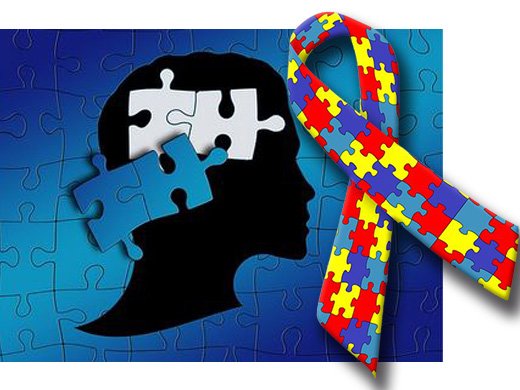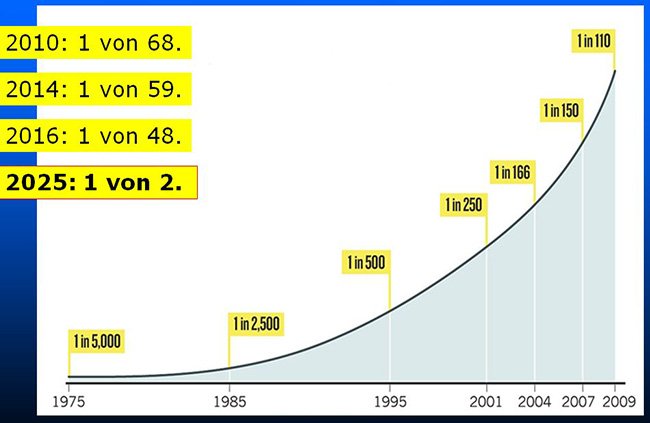by Dr.Harald Wiesendanger– Klartext 20. Feb. 2020
What the mainstream media is hiding
More and more children in Western industrialized countries are suffering from autism – the number of cases has exploded since the 1970s. What government authorities offer as an explanation tends to obscure the presumed main causes rather than illuminate them. The image and business of key industries are at stake, especially Big Pharma, the chemical sector, agriculture, and the food industry.

Autism cases among minors are now reaching epidemic proportions, particularly in the United States. While one in 5,000 children was affected in the mid-1970s, 20 years later, it was one in 500, and at the turn of the millennium, it was one in 250. In 2009, one in 110 US children was diagnosed with autism, and in 2016, one in 250 48. (According to the Federal Environment Agency, every hundredth child is affected in Germany.) The devastating forecast: If the trend continues, by 2025, at least in the USA, every second child will be autistic.

New diagnostic criteria and increased disease awareness only partially explain the increase. Independent doctors suspect chemicals – but their warnings are barely getting through, and their research funding is insufficient.
One trace leads to pesticides. Unborn babies are particularly sensitive to them. If they are exposed to large amounts of pesticides in the womb, their risk of autism increases. This results from a Californian study in which scientists determined where around 1,000 mothers were during their pregnancy. They related these places to the use of pesticides. In California, farmers have to record in writing what they spray on their fields, when and where, in so-called “Pesticide Use Reports.” Mothers who lived within 1.25 to 1.7 kilometers of treated fields during pregnancy had a two-thirds increased risk of having a child with autism or another intellectual developmental disorder.
In August 2018, a study appeared in the American Journal of Psychiatry that also suggests a connection between the risk of autism and pesticide exposure. Researchers from Columbia University’s Mailman School of Public Health in New York City and scientists from the Finnish University of Turku and the National Institute of Health and Welfare, Finland, cooperated. The researchers focused on DDT (dichlorodiphenyltrichloroethane). DDT is considered a carcinogenic substance and a so-called endocrine disruptor, meaning it is a substance that affects the hormonal balance and can disrupt the development of embryos and children. Because DDT can cross the placenta, the poison passes directly to the unborn child and can affect its development. Breast milk is also still contaminated with DDT. For the above study, researchers analyzed data and blood samples from more than 750 autistic children and a matched number of healthy children and their mothers. (The data came from the Finnish Prenatal Study of Autism.) It was found that the risk of being born with autism was, on average, a third higher if the mother had elevated levels of DDE in the blood. DDE is a breakdown product of DDT. At very high values, the risk of autism was twice as high.
But pharmaceuticals are also under reasonable suspicion. When expectant mothers swallow asthma medications, antidepressants, or over-the-counter painkillers like acetaminophen, they dramatically increase their child’s risk of autism.
A study from the University of Montreal analyzed data from over 145,000 pregnant women who had taken antidepressants. In doing so, they increased the risk of autism by a shocking 87 percent. The effect was strongest with the so-called serotonin reuptake inhibitors (SSRIs). (6 to 10 percent of all pregnant women are prescribed antidepressants by their doctors.)
It is estimated that 65 percent of all pregnant women take the over-the-counter pain and fever medication paracetamol (acetaminophen) during pregnancy. A Norwegian study evaluated data from 48,000 Norwegian children whose mothers took part in a survey about their medication habits in the 17th and 30th weeks of their pregnancy. Further data were also collected six months after delivery. The children’s intellectual development was examined at the beginning of the third year of life. The results obtained in this way could now be linked to the use of medication in the late phase of pregnancy. The researchers found that approximately 4 percent of women had taken paracetamol for at least 28 days during pregnancy. The children in this statistical subgroup were also more likely to have developmental and behavioral problems than children whose mothers took paracetamol less often or not at all. “Our results suggest that paracetamol is not as harmless as we always thought,” said Ragnhild Brandlistuen, the study leader at the University of Oslo. “Long-term use of acetaminophen increased the risk of behavioral problems by a remarkable 70 percent in our study.”
Asthma medications also appear to increase the risk of autism when taken by the expectant mother during pregnancy. Danish researchers have been studying these connections for nine years. To do this, they used data on over 57,000 children born between 1996 and 2006. Of these, 52,000 were without, and 5,200 with an autism diagnosis. It has been shown that children are 30 percent more likely to receive an autism diagnosis if their mothers have taken certain asthma medications, the so-called beta-2 agonists. They have a bronchodilator and anti-inflammatory effect, making coughing up mucus easier. The drugs reach the embryo via the placenta and influence the developing nerve cells. Beta-2 agonists include active ingredients such as salbutamol, fenoterol, and reproterol.
Additives in vaccine serums, particularly aluminum, could also be fueling the autism epidemic. Back in 2011, the Journal of Inorganic Biochemistry found that children from countries with the highest autism rates had the highest levels of aluminum exposure from vaccines. – The specialist magazine Entropy published a study in 2012, according to which the number of new autism cases rose steadily after the aluminum content in vaccines was increased.
All chemicals that affect the child’s developing brain probably play a role, but also those that influence the hormonal or immune system. These include heavy metals such as lead and mercury, flame retardants, polychlorinated biphenyls, phthalates, and some volatile organic compounds (VOCs) such as trichloroethylene and styrene.
(Harald Wiesendanger)
Support “Ways Out Charity“! With your support, we can help and move forward. > https://bit.ly/3wuNgdO
Sources
Janie F. Shelton u.a.: “Neurodevelopmental Disorders and Prenatal Residential Proximity to Agricultural Pesticides: The CHARGE Study “, Environmental Health Perspectives 122, 23.6.2014, S. 1103-1109, http://dx.doi.org/10.1289/ehp.1307044.
Alan S. Brown u.a.: “Association of Maternal Insecticide Levels With Autism in Offspring From a National Birth Cohort, “16. August 2018, American Journal of Psychiatry
Takoua Boukhris u.a.: “Antidepressant Use During Pregnancy and the Risk of Autism Spectrum Disorder in Children, “JAMA Pediatrics 1/2015, DOI: 10.1001/jamapediatrics.2015.3356
R. E. Brandlistuen u.a.: “Prenatal paracetamol exposure and child neurodevelopment: a sibling-controlled cohort study”, December 2013, International Journal of Epidemiology,
B. Gidaya u.a.: “In utero Exposure to β-2-Adrenergic Receptor Agonist Drugs and Risk for Autism Spectrum Disorders”, PEDIATRICS, 2016.
L. Tomljeniovic u.a.: “Do aluminum vaccine adjuvants contribute to the rising prevalence of autism?”, Journal Inorg Biochem, November 2011
S. Seneff u.a.: “Empirical Data Confirm Autism Symptoms Related to Aluminum and Acetaminophen Exposure”, Entropy 2012.
Grafik: K. Weintraub: „Autism counts“, Nature 479/2011, S. 22-24. Statistik ab 2010: CDC, www.cdc.gov/ncbddd/autism/data.html
Harald Wiesendanger, epidemic, autism, vaccines, endocrine disruptors, autism research, pesticides, antidepressants, aluminum, autism risk, serotonin reuptake inhibitors
